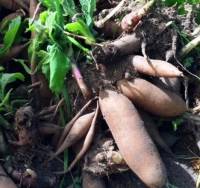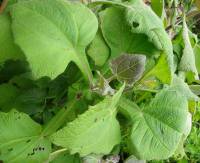PLANT DESCRIPTION A 'winter treat'. Yacon is native to Colombia and Ecuador and is a hardy, attractive herbaceous perennial that yields a large harvest of tubers. The tubers have an appealing crunchy crispness that is a cross between apple and watermelon, with overtones of sugarcane. As a member of the sunflower family, yacon can grow to 2 metres in height with small, daisy-like yellow flowers. When growing it is similar in appearance to Jerusalem artichokes but is not invasive in the same way. PLANTING DETAILS Produces two types of tubers, reddish rhizomes directly at the base of the stem, can be eaten young but best used for propagation and the larger brown tubers, which are mainly eaten. The brown tubers are dried in the sun and then stored. The reddish rhizomes are kept out of the sun and covered with slightly damp sand, sawdust or cocopeat to stop them drying out and put aside for replanting in a dark, dry place. As soon as the rhizomes begin to sprout it is time to plant. Prepare the soil by loosening well with a fork and working in compost. To plant, cover a large rhizome which has several sprouts, with soil to a depth of 3 cm. Mulch well, yacon will grow up through the mulch, just like potatoes. Plants are large and vigorous, so space them at least 0.5 metres apart. Yacon grows fast even in poor soils but crops best in rich, friable, well-drained soil. Yacon can be planted all year round in frost-free areas as it is day-length neutral. It appears to be drought tolerant compared to other vegetable crops and so far, pest-free. For cold areas of Australia the rhizomes can be started in styrofoam boxes in a greenhouse or on a warm verandah and planted out when frost is past. HARVEST The plant takes 6 - 7 months to reach maturity. After flowering top growth withers and dies back and the tubers are harvested. They resemble dahlia or sweet potato tubers. Once the soil starts to heave at the base of the plant, dig around to 'bandicoot' a few early tubers to extend the harvest season. The tubers continue to sweeten as the plant dies back so the main harvest should only take place once all the top growth is dead, usually by May. The plant needs to be dug carefully to avoid damage to the crisp tubers. Store tubers in a cool, dark and dry place with good air circulation for some months. The average sugar content of the tubers increases during storage because of starch conversion. They can also be exposed to the sun for up to 2 weeks to accelerate the sweetening process.

